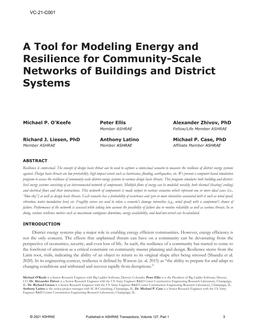
VC-21-C001 — A Tool for Modeling Energy and Resilience for Community-Scale Networks of Buildings and District Systems
- Comments Off on VC-21-C001 — A Tool for Modeling Energy and Resilience for Community-Scale Networks of Buildings and District Systems
- ASHRAE
Click here to purchase
Resilience is contextual. The concept of design basis threat can be used to capture a contextual scenario to measure the resilience of district energy systems against. Design basis threats are low-probability, high-impact events such as hurricanes, flooding, earthquakes, etc. We present a computer-based simulation program to assess the resilience of community-scale district energy systems to various design basis threats. This program simulates both building and district- level energy systems consisting of an interconnected network of components. Multiple flows of energy can be modeled: notably, both thermal (heating/cooling) and electrical flows and their interactions. This network of components is made subject to various scenarios which represent one or more ideal cases (i.e., “blue-sky”) as well as design basis threats. Each scenario has a probability of occurrence and zero or more intensities associated with it such as wind speed, vibration, water inundation level, etc. Fragility curves are used to relate a scenario’s damage intensities (e.g., wind speed) with a component’s chance of failure. Performance of the network is assessed while taking into account the possibility of failure due to routine reliability as well as various threats. In so doing, various resilience metrics such as maximum contiguous downtime, energy availability, and load-not-served can be calculated.
Citation: 2021 Virtual Conference Papers
Product Details
- Published:
- 2021
- Number of Pages:
- 9
- Units of Measure:
- Dual
- File Size:
- 1 file , 760 KB
- Product Code(s):
- D-VC-21-C001

